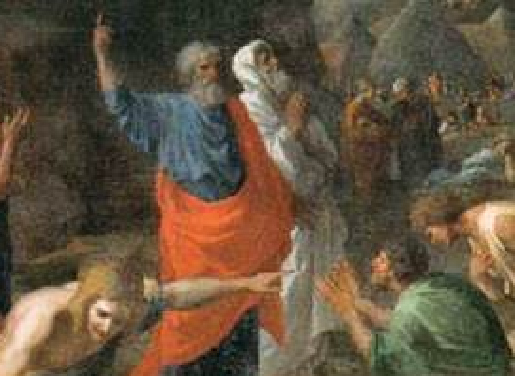
"Reading Pictures," PMLA 134.1 (2019) © Modern Language Association of America.
James A. W. Heffernan
Fully illustrated, corrected, and posted here 9 January 2024. Except for purely private purposes and / or explicitly cited fair use of up to 300 words, no part of this essay may be copied without the express permission of the author and PMLA. My warm thanks to Andrew Foust for his expert help in posting this version.
WHAT DO WE MEAN BY READING? READERS OF THIS JOURNAL would undoubtedly say that first of all it means perusing a text. But the Oxford English Dictionary (OED) lists many other meanings, including to "analyse or interpret (any cultural product, as a film, ritual, etc.) using methodology analogous to literary criticism or interpretation" ("Read, V. 7a"). Does this definition-- which the OED calls figurative--mean that we can readily slide from decoding texts to decoding pictures? As interpreters of literature, we are all accustomed to glossing images in texts, but, as W. J. T. Mitchell has recently reminded us, images and pictures are not the same. "The picture," he writes, "is a material object, a thing you can burn or break or tear. An image is what appears in a picture, and what survives its destruction--in memory, in narrative, in copies and traces in other media" (Image Science 14--15). Pictures likewise differ from textualized images. In a text, an image denotes an object that can be visualized in various ways as well as metaphorically construed. For instance, in James Joyce's Ulysses the image of a key can be visualized as just about anything small, hard, and straight that is capable of opening locks; it can also be metaphorically identified with an erect phallus, the key to Molly's body that the wandering, secondarily impotent Bloom (who forgets his house key) has long been unable to forge.1 In the world of pictures, an image--what art historians call a motif--is an object that can be depicted in various ways. For instance, the image of the book in Renaissance paintings of the Annunciation can be painted as large or tiny, wide open or nearly closed, clutched by Mary or resting in her lap.2 But, unlike a textual image, which can be visualized in various ways (your image of a key would differ from mine), a depicted image is inelastic. In a picture, the mobile and mutable image normally assumes a fixed size, hue, and form. (I say "normally" because digital technology has now made some pictures kinetic, as noted later on.)
Reading a picture, then, is not the same as reading the images we commonly meet in texts. Nevertheless, I aim to show why the act of interpreting a picture deserves to be called reading, not just figuratively or in quotation marks but by full right--as a matter of critical precision. Unlike the OED, I do not believe that reading pictures means simply applying to them the techniques developed by literary criticism. While a great deal of visual art contains words that must be read in the textual sense, and while a significant number of recent pictures are made of nothing but words, reading pictures means recognizing and reckoning with the distinctive character of pictorial signs as well as with the indeterminacy of pictorial marks.
Pictorial signs and marks inhabit many kinds of pictures, including photographs and abstract art. Among others, Susan Sontag (On Photography) and Roland Barthes have shown us how deeply photographs may be interpreted, and, in defiance of Sontag's claim that abstract painting cannot be interpreted at all ("Against Interpretation" 657), art critics such as Rosalind E. Krauss have shown that even the grids of Agnes Martin can be decoded--if only as signs of modern art's "hostility to literature, to narrative, to discourse" (Krauss 9).3 Given the constraints of space, I have chosen to focus on representational paintings as well as on pictures made of words, including projections, which, paradoxically, foreground in a particularly vivid way the difference between reading texts and reading pictures. Reading pictures made of words, I contend, is unregulated by the rules of grammar and yet governed by pictorial conventions, strictly circumscribed by the particular forms and colors that objects must assume in any one picture.
In the Western world, the long history of theorizing about the relations among language, literature, and visual art begins with a formulation that loads the dice in favor of words. Sometime before the middle of the fifth century BCE, the Greek lyric poet known as Simonides of Ceos reportedly stated that "[p]ainting is mute poetry, poetry a speaking picture" (qtd. in Plutarch 346). In his admirably compact history of interart theory from the classical period to the Renaissance, Leonard Barkan takes Simonides's dictum as his point of departure, but in observing that it "seems to be even-handed," he curiously fails to note that its chiastic symmetry masks a radical asymmetry: while poetry equals picture plus speech, painting equals poetry minus speech. Nevertheless, the logocentrism lodged in what is perhaps the oldest known formula for interart relations is the key to Barkan's argument about the history of those relations up to and through the Renaissance. From Aristotle to Philip Sidney, Barkan contends, logocentric theorists use "the point that x is true of pictures" to argue that x is "also true of poems," but x "refers to a set of properties that word-makers have imposed on pictures" (30).
To grasp the distinctive quality of the pictorial sign, to understand just how this would-be silent object actually speaks, we must first recognize another kind of asymmetry that complicates the relation between verbal and visual arts: while it is quite possible to study the history of literature without looking at a single picture, it is impossible to learn the history of art without reading a wide variety of texts. Virtually everything we know about ancient art comes to us in words. For instance, we know the works of Zeuxis and Parrhasius through the verbal testimony of Pliny the Elder, who tells us how they competed in the art of pictorial illusion (330). Likewise forced to lean on ancient texts is Leon Battista Alberti, the Italian quattrocento humanist who declares that painters must be highly literate--conversant with poets, orators, and other learned writers--even while he insists that painting represents only the visible (43). And no wonder: except for the frescoes of Giotto, the only sources given for the paintings described in Alberti's De Pictura (1435; "On Painting") are ancient poets and orators.4
However, while working in Rome about two hundred years later, Nicholas Poussin produced what he considered a fully legible painting, and since this painting is now on view in the Louvre, it allows us to test the artist's claim that pictorial signs may indeed be read. On 28 April 1639, Poussin wrote from Rome to his patron Fréart de Chantelou, in Paris, to report that he was sending him what Chantelou had commissioned: "votre tableau de Manne" ("your painting of manna"; Letter 35), now commonly known as Israelites Gathering Manna in the Desert:
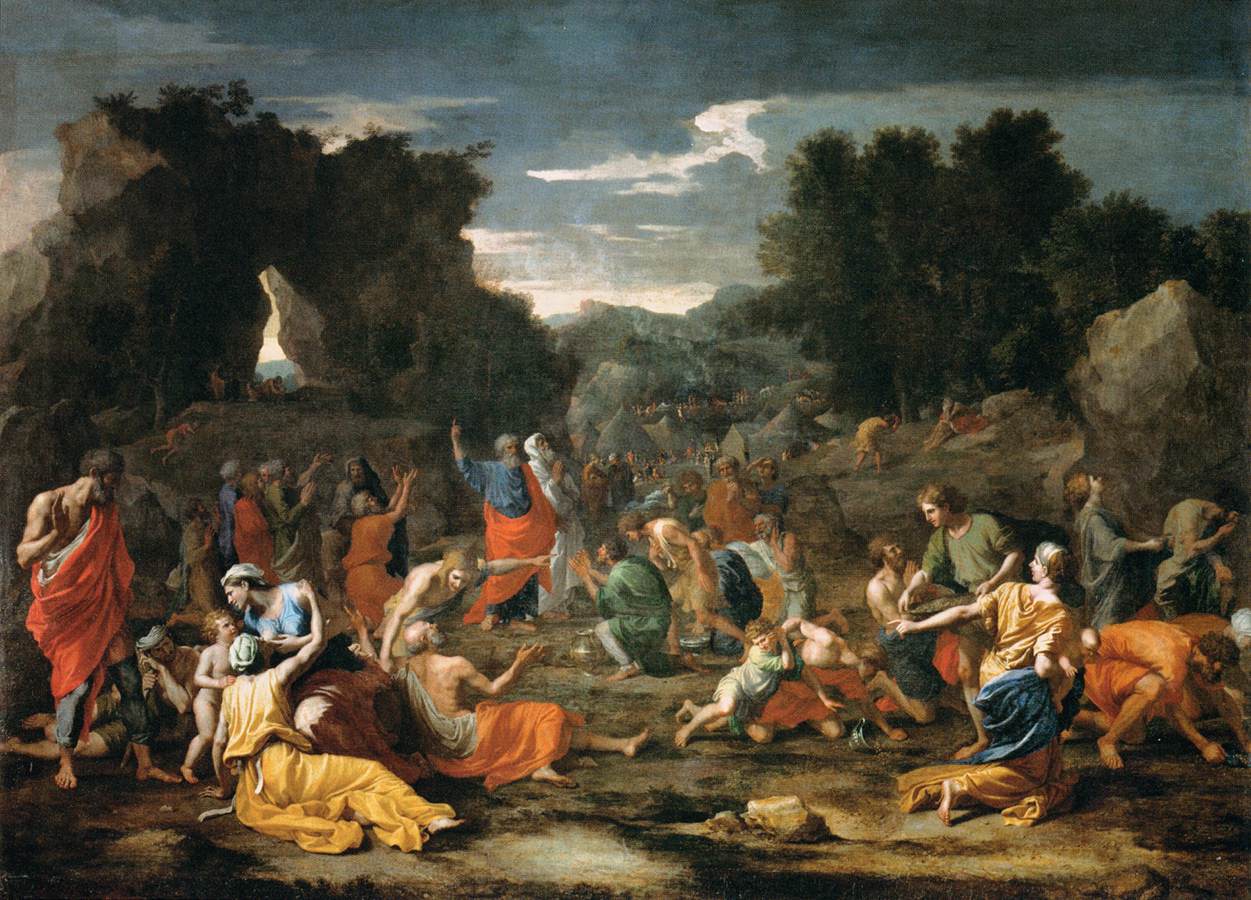
Nicholas Poussin, Israelites Gathering Manna in the Desert (1637-39). Oil on canvas.
Paris, Musée du Louvre.
Though the painting presupposes knowledge of Exodus 16, Poussin points to another text: a now lost "première lettre" ("first letter") in which he promised to depict certain "mouvements" ("movements") (36). Eager to show that he has kept his promise, he writes:
[J]e crois que facilement vous reconnaîtrez quelles sont celles qui languissent, qui admirent, celles qui font pitié, qui font action de charité, de grande nécessité, de désir de se repaître, de consolation et autres, car les sept premières figures à main gauche vous diront tout ce qui est ici Écrit et tout le reste est de la même étofe: lisez l'histoire et le tableau, afin de connaître si chaque chose est approprié au sujet.(36).
I believe that you will easily recognize those who are languishing, those who are struck with admiration, those who take pity, who perform charitable acts, who carry out acts stemming from great misery, from the desire for bodily refreshment, for consolation and other things, because the first seven figures on the left will tell you all that is written here and all the rest is from the same cloth: read the story and the painting to find out if each thing is appropriate to the subject. (trans. in Marin, "On Reading Pictures" 11)
Over thirty years ago, Louis Marin took this letter as a point of departure for an essay on the reading of pictures ("On Reading Pictures"), written soon after he had analyzed Poussin's The Arcadian Shepherds as a way of sketching out a theory of pictorial reading ("Toward a theory of Reading"). Highlighting, respectively, two different paintings dating from the same year (1639), both essays exemplify ways of reading what are traditionally called "history paintings"--paintings based on stories (whether factual, biblical, or literary)--and both apply Erwin Panofsky's theory of pictorial meaning, which distinguishes between motifs and literary themes: while motifs are "primary or natural" objects and expressions such as a pose or gesture (5), themes or concepts are iconographically signified by means of visual allusion to a literary source, as when a male figure with a knife signifies St. Bartholomew, who was flayed to death (6). "A motive," Marin observes, "implies a practical recognition of gestures, things, persons; a story implies literary knowledge" ("Toward a Theory of Reading" 295).
Without raising any questions about the pictorial signification of things we are said to know by "practical" or "natural" recognition, Marin defines pictorial reading as a process of uncovering the story--the verbal narrative--told by a painting that "translate[s]" it into "visual images" ("On Reading Pictures" 6). For Marin, reading pictures means translating their "visual images" back into the words of a story. Drawing on Émile Benveniste's distinction between discours ("discourse") and récit ("narrative"), Marin argues that painting banishes the narrator "as the subject of enunciation (discourse)" and "displays in its own language the narration of an event" ("Toward a heory of Reading" 295), which is to say--as he goes on to do--that "events seem to tell themselves" (299). But they do so only by means of the viewer or reader. "[I]n front of the painting," writes Marin, "the viewer tells a story to himself, he reads the painting, he understands the narrative messages. This means that he converts the iconic representational model into language" (298), turns the "moment of representation" into "actual temporal succession" (299).
Besides applying Panofsky and Benveniste, Marin's formula for pictorial reading recalls both the practice of an ancient Greek rhetorician named Philostratus and the pictorial theory developed by G. E. Lessing in the eighteenth century. In the third century CE, Philostratus described a series of paintings "for the young, that by this means they may learn to interpret paintings" (5), and to this end he turned each painting into a narrative, or delivered the narrative implied by what Lessing later called the "prägnantesten" ("most pregnant" [Laokoon ch. 16; Laocoön 78]) moment of action that the painting represents. Poussin's Israelites Gathering Manna tells its story by representing what may seem to be two moments:
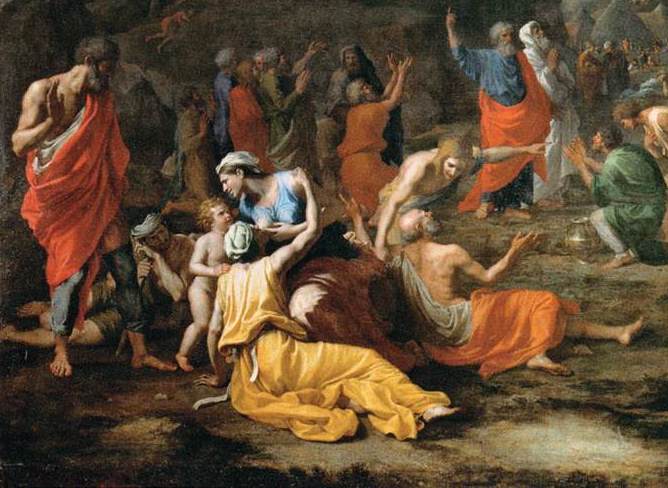
Poussin, Gathering of Manna. Detail of lower left side.
on the left the misery of the starving family, which includes a woman breastfeeding her own mother while holding off her anxious infant, and on the right the joy of various figures discovering the manna. According to Charles Le Brun, who led a conference on the painting at the French Academy in 1667, Poussin had to depict the desperation of the Jewish people in order to stress the grandeur of the miracle that relieved them ("Les Israelites" 62; see Dowley 330).
This way of reading the painting does not necessarily turn it into a sequence of events. Though one participant in the conference argued that the starving family on the left temporally precedes the rejoicing groups on the right, Le Brun finds the young mother to be so caught up in filial piety that she ignores the manna falling around her even as the young man standing next to her and supporting a seated old man is pointing to it: clear signs that the events are simultaneous ("Les Israelites" 57--58; see Dowley 334). Marin, however, is concerned less with solving the problem of pictorial narration than with using both Poussin's letter and his painting to generate a theory of pictorial reading. Even though lisez in seventeenth-century French could be used figuratively, or as a synonym for "study" (Dowley 335), Marin takes it literally, or textually.
The seven figures in the left foreground, he writes, "are the first read, for they are to the left and we read a text from left to right" ("On Reading Pictures" 12)--though the Hebrew text of Exodus itself, of course, would have been read from right to left. But in Marin's reading, the seven figures on the left express themselves--"speak visually"--in such a way as to make all the other figures legible (12). Noting that Poussin himself likened the twenty-four letters of the French alphabet to the expressive features of the human body, Marin writes: "the gestures and movements are like the letters of the alphabet, the figure which incorporates them is like both the noun and the verb of a passion and the whole assemblage of figures is like a narrative statement" (11). But this whole set of analogies presupposes that the body speaks a natural, universally intelligible sign language. Its "gestures," writes Marin, "would be signifiers and [its] signifieds would be the passions of the soul that characteristic names would designate . . ." (11--12).
Intentionally or not, Marin's wording echoes that of Alberti, who wrote that the historia of a painting--its essential story--"will move the soul of the beholder when each man painted there clearly shows the movement of his own soul" (77). In Marin's reading of Israelites Gathering Manna, the figure on the extreme left looking at the nursing mother shows by the raising of his right hand that he is struck with admiration for her Roman charity, and with this admiration--"the theoretical passion of the true vision of the painting" (Marin, "On Reading Pictures" 14)--he prompts us to read the gestures of Moses and Aaron in the middle of the picture: as Moses points upward to the invisible source of the miraculous food, "Aaron, hands clasped, eyes lifted, gives thanks to God for his infinite charity" (15):

This is a plausible reading of all five figures involved here, but instead of demonstrating that all of them "speak visually" in naturally recognizable signs, it presuppose knowledge of at least two texts--Poussin's letter and Exodus 16, without which we could hardly identify Moses and Aaron. Most important, it presupposes that the figure with the raised hand signifies admiration: that he "is like both the noun and the verb" of the passion that Poussin's letter identifies and that Marin thinks the viewer should feel while contemplating the picture (Marin, "On Reading Pictures" 11; see 14--15). But neither the gesture nor the expression of the figure on the left constitutes a naturally recognizable sign of admiration. On the contrary, the figure fails to display the one thing that both Le Brun himself and modern physiologists have identified as the leading sign of "admiration with astonishment": an open mouth (see Le Brun, Admiration; Fruda 119):
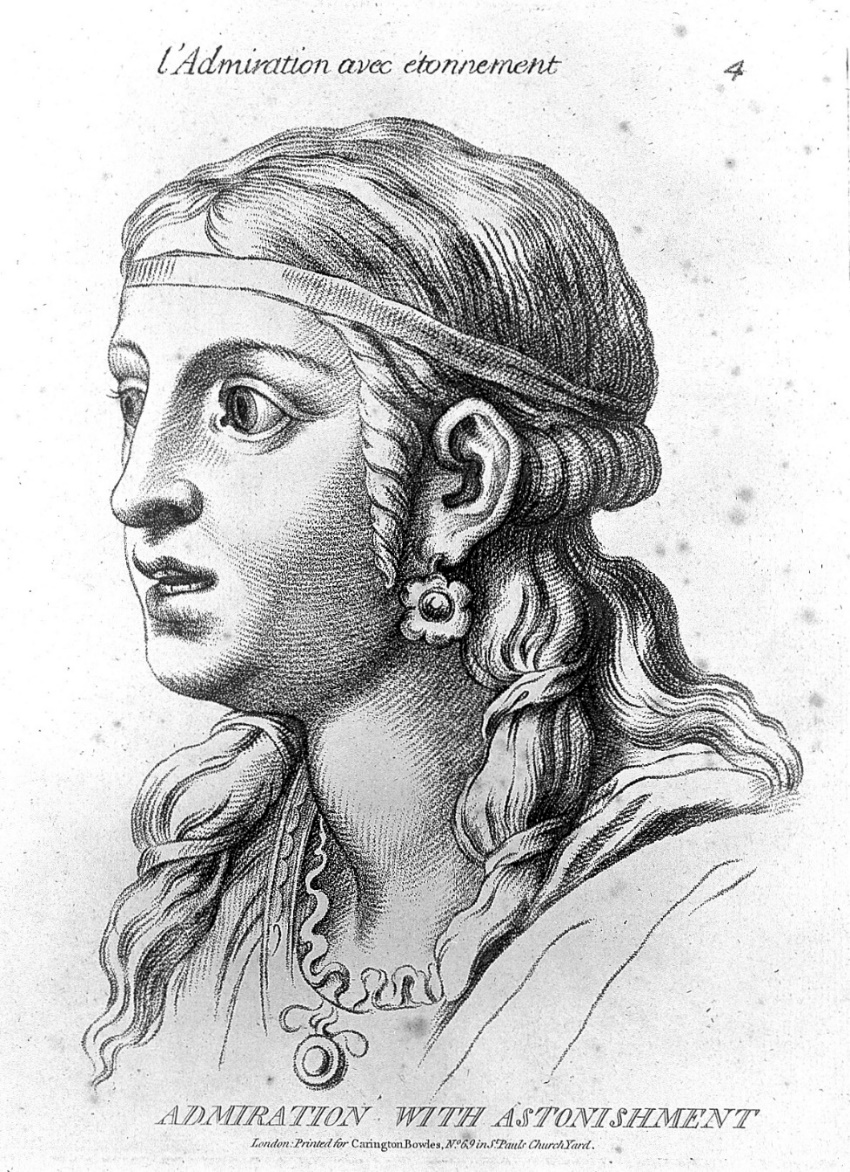
Astonishingly enough, Le Brun reads the closed mouth of Poussin's figure as a sign of his astonishment:
sa bouche est fermée, comme s'il craignoit qu'il lui échappât quelque chose de ce qu'il a conâu, et aussi parce qu'il ne trouve pas du parole pour exprimer la beauté de cette action" (his mouth is closed, as if he feared that there would escape him something of what he has conceived, and also because he cannot ind a word to express the beauty of this action;" Les Israelites 57).
But is this reading based on the natural sign language of the body? And must the raised hand necessarily signify admiration rather than simply shock or even aversion at the sight of an old woman sucking her daughter's breast? Without the term furnished by Poussin's letter, would Le Brun or Marin or anyone else read either the closed mouth or the raised hand as a sign of admiration?
Marin not only presupposes that the would-be legibility of a seventeenth-century history painting may be made to exemplify "what . . . a reading of a painting consist[s] of" ("On Reading Pictures" 11) and thus--presumably--to certify the legibility of all paintings. He also assumes that all gestures depicted in the painting are, in Panofsky's words, "carriers of primary or natural meanings" (5), even though their meanings have been pre-established by a text. Marin's theory of pictorial reading leaves open--or at least unanswered--the question whether a pictorial sign can be read independently of any previous text, can be interpreted without re-course to a label for which it is precoded.
The notion that pictures are automatically readable--instantly recognizable by natural resemblance to what they represent--underlies the long history of theorizing about the diference between pictures and words, which signify by means of arbitrary convention. Surprisingly enough, the theorist best known for his essay on the difference between words and pictures actually treated both of them as signs. But in defining poetry as essentially temporal and visual art as essentially spatial, Lessing makes both depend on a natural correspondence that aims to elide the process of decoding and hence reading signs, to make them windows through which we sensuously, intuitively see the natural world of time and space. He writes:
Ich schließe so. Wenn . . . die Malerei zu ihren Nachahmungen ganz andere Mittel, oder Zeichen gebrauchet, als die Poesie; jene nämlich Figuren und Farben in dem Raume, diese aber artikulierte Töne in der Zeit; wenn unstreitig die Zeichen ein bequemes Verhältnis zu dem Bezeichneten haben müssen: so können nebeneinander geordnete Zeichen auch nur Gegenstände, die nebeneinander, oder deren Teile nebeneinander existieren, aufeinander-folgende Zeichen aber auch nur Gegenstände ausdrücken, die aufeinander, oder deren Teile aufeinander folgen. (Laokoon ch. 16)
I reason thus: if . . . in its imitations painting uses completely different means or signs than does poetry, namely figures and colors in space rather than articulated sounds in time, and if these signs must indisputably bear a suitable relation to the thing signified, then signs existing in space can express only objects whose wholes or parts coexist, while signs that follow one another can express only objects whose wholes or parts are consecutive. (Laocoön 78)
In fact, shortly after Laocoön first appeared, Lessing told a correspondent that painting should use only "natural signs" (qtd. in Krieger 48).5
Though the problematic concept of the natural sign seems to bridge the divide between nature and convention in Lessing's theory of visual art, the rise of semiotics has merely driven them farther apart. Forty years ago, explaining C. S. Peirce's typology of signs (icon, index, symbol), Jonathan Culler wrote that "the icon involves actual resemblance between signifiant and signifié: a portrait signifies the person of whom it is a portrait not by arbitrary convention only but by resemblance," which he goes on to call "natural resemblance." Yet, "[i]n the sign proper as Saussure understood it," Culler adds, "the relationship between signifier and signified is arbitrary and conventional . . ." (16). Natural signs, therefore, can take their place in the realm of semiotics only if they have been denaturalized.
For semiotically minded theorists, all visual art is a compendium of denaturalized signs. In Vision and Painting, Norman Bryson took arms against what he called the "doctrine of Perceptualism" espoused by E. H. Gombrich (xii). According to Gombrich, whose theory of art and its history was largely based on the psychology of illusion, painting is a record of perception that recreates for the viewer what the artist has seen.6 Contesting this doctrine as it applied to figural painting (it hardly fits abstract art), Bryson deifned painting as "an art of signs, rather than percepts" (xii). Amplifying Ferdinand de Saussure's conception of meaning as the product of binary oppositions among signs in an enclosed system, Bryson argued that painting "is an art in constant touch with signifying forces outside" it (xiii). The viewer, therefore, must become an "interpreter" who decodes its signs in the light of the world that produces them (xiv).
Three years after Vision and Painting appeared, Mitchell published Iconology, the first of a series of books that has made him the premier theorist of interart relations in our time. Like Bryson, Mitchell regards pictures as pictorial signs, and he strongly contests Gombrich's claim that pictures even partly signify objects by means of natural resemblance rather than by convention, as words do (Gombrich, "Image and Code"). "The history of culture," Mitchell writes, "is in part the story of a protracted struggle for dominance between pictorial and linguistic signs, each claiming for itself certain proprietary rights to a 'nature' to which only it has access" (Iconology 43). Central to Mitchell's ongoing case against this proprietary claim is the conviction that words, pictures, and images deeply inform each other. Just as language is so thoroughly steeped in metaphorical images that we can hardly say where "image" ends and "word" begins, pictures can hardly be seen or read except in terms of language.
Nevertheless, semiotic theory has not yet vanquished perceptualism, nor has it solved what might be called the enigma of recognition. In identifying what pictures and even photographs represent, we may well be reading them through the framework of cultural conventions, as semioticians argue. But how can cultural conventions explain our capacity to recognize pictures made by people to whose culture we have no other access--such as the Paleolithic cave paintings in Lascaux, France, which depict what are widely recognized as horses, stags, a bison, and a bull?
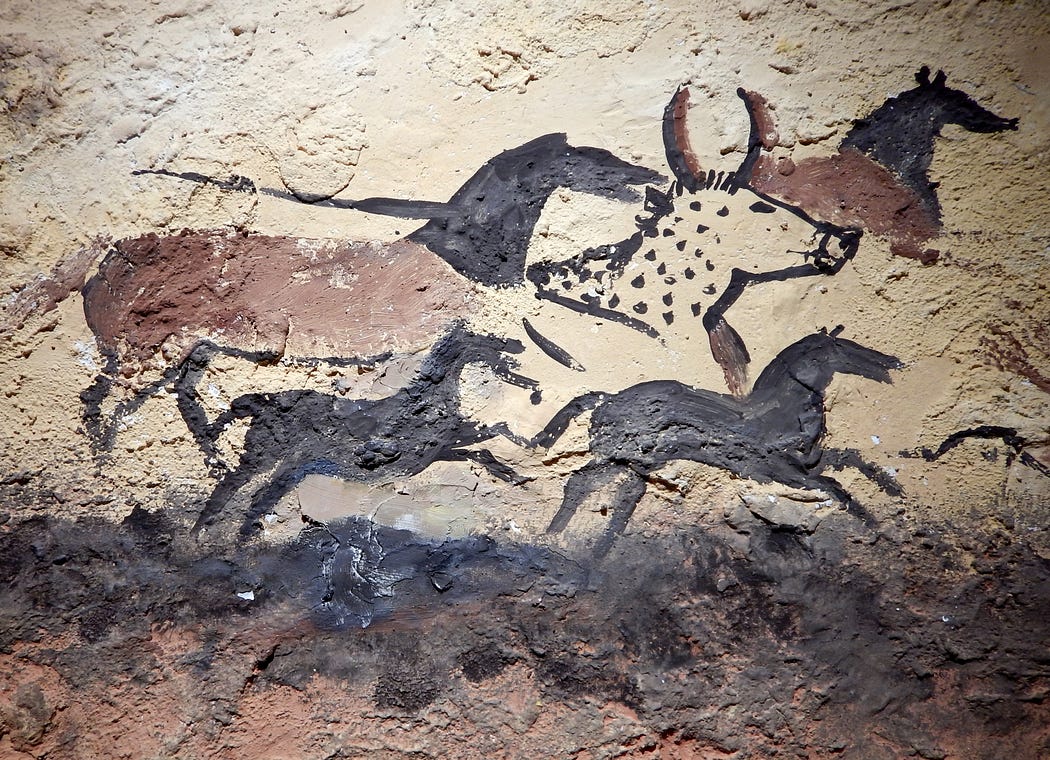
Lascaux painting from a network of caves near the village of Montignac, in the department of Dordogne in southwestern France, now usually estimated at around 17,000 years (early Magdalenian).
Recognition, in short, has yet to be banished from the experience of art, has yet to be subsumed by any theory that would simply equate the viewing of a picture with the decoding of signs. What Mitchell wrote over twenty years ago remains true today: in an age of "all-pervasive image-making, we still do not know exactly what pictures are, what their relation to language is, how they operate on observers and on the world, and what is to be done with or about them" (Picture Theory 13; my emphasis). The point I have italicized is the key one. No linguistically based theory of signs can exhaust the meanings generated by visual art, and no label can predict all that we can discover in the patient scrutiny of a painting, some of whose most poignant features may be impossible to name.
At the same time, it is undeniable that reading--by which I mean the strictly lexical process of perusing words--plays a crucial role in our experience of art. Though John Dryden told Sir Godfrey Kneller in the late seventeenth century that his "pencil [i.e. paintbrush] speaks the tongue of ev'ry land" (Find in page), the sight of a picture in a museum or gallery routinely prompts us to look for and read its title. This simple fact reminds us--or should remind us--that art has needed verbal mediation ever since it began to be offered to the public. In the fourteenth century, the illuminated biblia pauperum ("bibles of the poor") spoke to the illiterate only when the pictures were explained in spoken words:7 more recently, paintings have presupposed literacy as a prerequisite to viewing them. In nineteenth-century England, the expansion of literacy made poetry available to hundreds of thousands while painting reached a much smaller audience in Royal Academy exhibitions and in museums such as London's National Gallery, founded in 1824. For this reason, as Ruth Bernard Yeazell has recently shown, artists could not do without words. In 1834, while preparing a second edition of prints based on his paintings, John Constable wrote a commentary on each one because, he said, "many can read print & cannot read mezzotint" (John Constable's Correspondence 108). Much earlier, in the spring of 1798, the twenty-three-year-old J. M. W. Turner began quoting poetry under the titles of his pictures in the Royal Academy exhibition catalog (Ziff 2), and, in the latter part of the next century, Dante Gabriel Rossetti was commended for associating his paintings with poetry and thereby helping "ordinary people" grasp their meaning (Yeazell 119).
Whether or not poetry can help ordinary people read a painting, almost every painting is now exhibited with a title (even if it is only Untitled), and, as Yeazell has argued, picture titles have profoundly informed our experience of art for the last three centuries. "From the eighteenth century to the present," she writes, "all [artists] participate in a culture in which the painter becomes, however minimally or reluctantly, also an author" (12). While not all artists choose the titles of their paintings, those who do are clearly asking us to view them in the light of those titles, so that reading a text (however minimal) becomes a prerequisite for reading a painting.
Compare, for instance, the full title of the painting commonly known as Whistler's Mother with the routinely condensed full title of one of Wordsworth's best known poems. "Lines Composed a Few Miles above Tintern Abbey, on Revisiting the Banks of the Wye during a Tour, July 13, 1798" is commonly called "Tintern Abbey" even though the full title locates the speaker upriver from the abbey, which is nowhere mentioned in the poem. Nevertheless, the abbey is the most conspicuous object mentioned in the title, just as the seated old woman whom James Abbott McNeill Whistler limns in profile is the most conspicuous object in his painting.
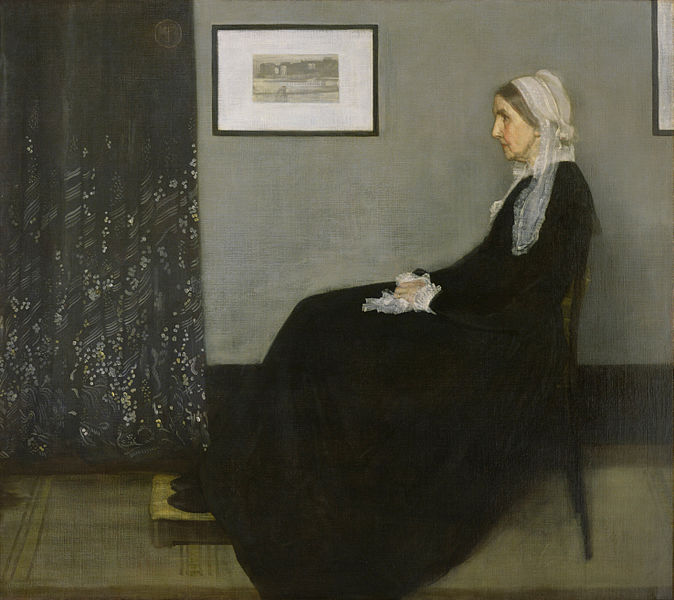
James McNeill Whistler, Arrangement in Grey and Black No.1: Portrait of the Painter's Mother (1871). Oil on canvas. Paris, Musée d'Orsay.
But, instead of treating this figure as the Panofskian vehicle of primary or natural meaning, Whistler's title asks us to focus on what the viewer sees (at least conceptually) before reading this figure as a seated woman: namely, the purely abstract features of the painting--its shapes and shades. Whistler's full title is Arrangement in Grey and Black, No.1:Portrait of the Painter's Mother. His title takes it for granted that we can recognize the profile of an old woman without verbal guidance, but before defining that sign any further, he asks us to focus on the elements that constitute it: an elongated oval of black juxtaposed with various shades and shapes of gray, exemplifying what James Elkins has called "sub-semiotic" marks. Semiotics, writes Elkins, "slights the meaning of marks," turning pictures into texts by viewing or reading only their nameable figures. Though Whistler has constructed a verbally identifiable sign from patches of black and gray, they exemplify what Elkins calls "the crucial moments of darkness" in art, "when the picture, in all its incomprehensible, nonlinguistic opacity, confronts us as something illegible" (834).
Here is a stubborn paradox. How could a painting of what we clearly recognize as a seated old woman be unreadable? Her figure is indeed a readable sign, but the shapes and shades used to generate it cannot be translated into specific words, cannot be named with anything like the precision applied to the figure. Yet the shapes and shades are essential parts of what we experience in viewing the picture, in absorbing both its nameable signs and unnameable marks.
Consider how Constable represents a woman in a painting from the early nineteenth century: Vale of Dedham.8
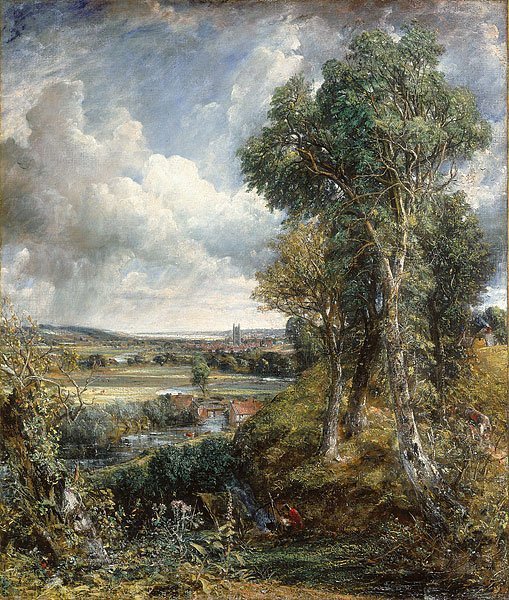
John Constable, Vale of Dedham (1828). Oil on canvas.
Edinburgh, National Gallery of Scotland.
In this case, the title tells us nothing about the painting except its location, which Constable had depicted some twenty-six years earlier in a painting called Dedham Vale.
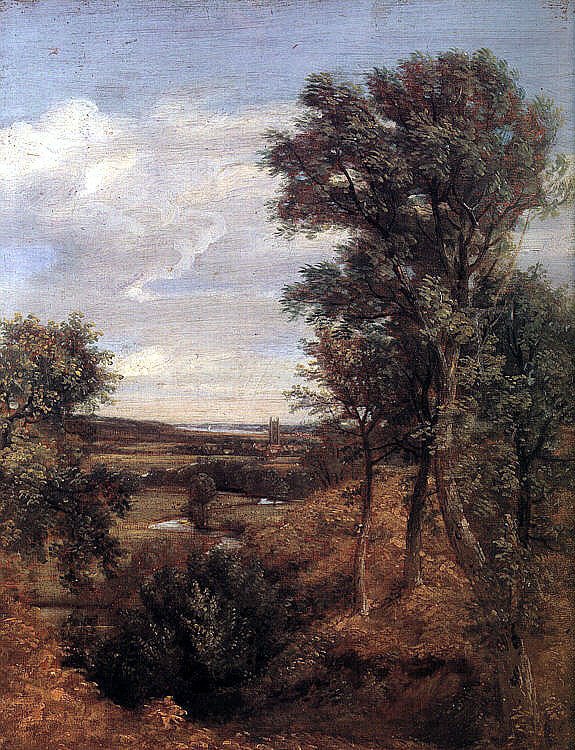
John Constable, Dedham Vale (1802). Oil on canvas. London, Victoria and Albert Museum.
Both paintings take their compositional cue from Claude's Landscape with Hagar and the Angel, a painting that Constable knew very well from the collection of George Beaumont (who eventually gave it to the National Gallery, in London) and that he reverently copied sometime before 1802 (Leslie 5).
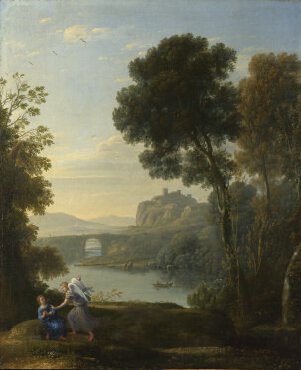
Claude Lorraine, Landscape with Hagar and the Angel (1646).
London National Gallery
In Constable's two paintings, as in Claude's Hagar and the Angel, foreground trees on the left and right form wing screens framing a vista through which a river meanders to a sea-coast town with its church tower in the background and billowing white clouds overhead. The lure of the vista is enhanced by chiaroscuro, which draws the eye over the shadowy foreground to the sunlit vista beyond.
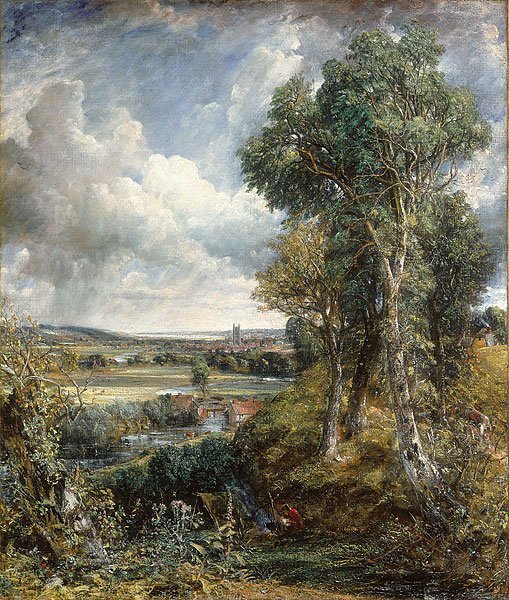
But the later painting--Vale of Dedham-- offers much more detail than the earlier one, especially in the foreground. If we resist the lure of the sunlit vista and look carefully into the shadows, we can barely see (in the lower right center of this detail) a tiny blob of red next to a tiny spot of white.
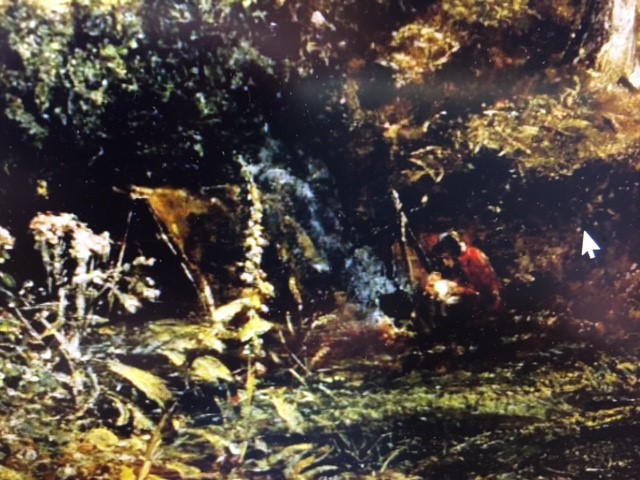
These bits of color might be read in purely formal terms, as picturesque highlights--subsemiotic touches meant to catch the eye in the shadow. But they can also be read as figural signs of a vagrant mother with her infant, cooking on an open fire beside a small, shadowed tent that mimics in its triangular shape the roof lines of the far more comfortable and substantial cottages flanking the river in the middle distance.
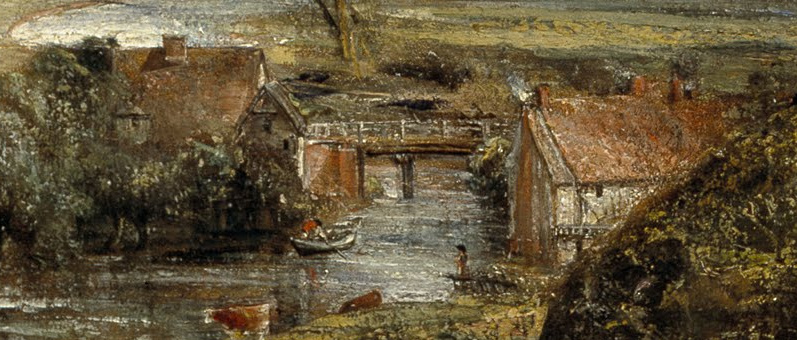
Just what is the factual meaning here-- the material objects or figures signified by the blob of red and the spot of white? This is precisely the question raised by the painting as it challenges our view of its picturesque composition. Since the cottages look much more like picture-book homes than does the little tent in the foreground, we are unlikely to recognize the tent as a home. The composition tempts us to overlook the tent and the figures beside it, who merely hover on the edge of signification.

According to John Barrell, Constable does not allow the impoverished mother and child to emerge from the shadows and solicit our pity (136--37). Instead, they are little more than a spot of red and a spot of white, picturesque or protoimpressionistic bits of chromatic texture in a composition governed by the formal patterns of chiaroscuro, and their shadowy lair is merely a foil for the glowing vista that we alone--not they--can see.
This is a plausible line of interpretation except for one thing. It does not explain why Constable enables us to recognize the destitution of the figures or why--for all their shadowiness--they are the only figures we can see in the painting. They are also the only counterpart to the biblical figures that appear in the foreground of Claude's Hagar and the Angel, the painting whose composition Constable recycles in both Dedham Vale and Vale of Dedham. When we recall that Hagar was an outcast, a serving woman expelled from Abraham's household after she conceived his child, it becomes possible to see the foreground figures in Constable's painting as contemporary outcasts, figures that society has no place for but that the artist--whatever his politics--cannot fail to notice and represent. They cannot simply be reduced to bits of picturesque texture.
Produced long after the works of Claude and Poussin, Vale of Dedham is Constable's way of re-creating what was once called "history painting." Reconceiving the traditional relation between landscape and the figures who populate it, he makes Claude's biblical outcasts give way to the human debris of contemporary history: to barely personified spots of life, nameless figures who play no visible part on the stage of public events but quietly insist on taking their place in the landscape of contemporary human experience. By recalling Claude's Hagar and the Angel, Constable's painting displays the formal structures that Panofsky's theory of pictorial meaning is equipped to explain. But in radically destabilizing the factual meaning of the figures in this picture, in painting daubs of color whose meaning depends on the very fact that we can barely recognize what they materially signify, Constable detonates the ground on which Panofsky's theory of pictorial meaning rests. To read this picture, we must study the point at which a subsemiotic mark becomes a verbalizable sign and then subtly takes its place in a context both pictorial and textual: history painting and scripture.
For one more example of what a nineteenth-century painter could do with the tradition of history painting, consider Vincent Van Gogh's Still Life with Bible, painted on a single day in October 1885, a few months after the death of his father.
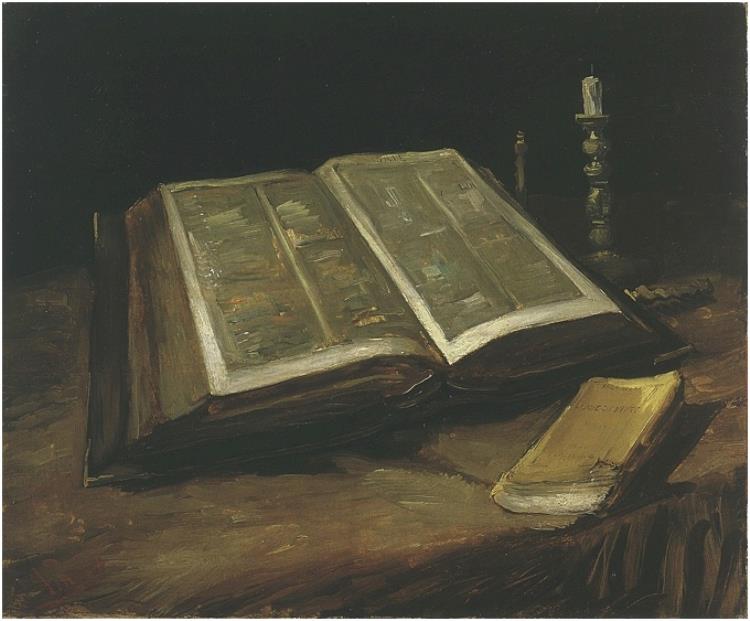
Vincent Van Gogh, Still Life with Bible (1885). Amsterdam, Van Gigh Museum.
As the son of a pastor in the Dutch Reformed Church who once dreamed of becoming a pastor himself and who spent parts of his early twenties preaching in England and Belgium, Van Gogh was steeped in the Bible. Yet as a voracious reader of modern literature, he rebelled against his father's fixation on scripture, which--as Vincent ruefully noted--led his father to stigmatize all modern authors as "thieves and murderers" (qtd. in Edwards 46). His painting translates this Oedipal conflict--a conflict all about reading--into the juxtaposition of two texts: his late father's leather-bound Bible, lying massive and open on a table, and--angled up against it--a small, closed, dog-eared paperback copy of Émile Zola's novel La joie de vivre ("The Joy of Life").
Generically, this painting exemplifies what I have elsewhere called lectoral art, which includes not only paintings such as Johannes Vermeer's Girl Reading a Letter (c. 1657) and photographs such as Sally Mann's Sunday Funnies (1991) but also pictures of books and other reading matter, texts "that could be read by anyone actually or potentially present within the space depicted--as distinct from words on the canvas that can be read only by the viewer" (Heffernan 36, 319n52).9 The Bible in this painting, of course, is almost wholly unreadable. Even though it lies wide open across the picture plane so that its lines of verse should be as legible as Zola's title, they are obscured by laddered streaks and vertical strokes of pigment arranged in four columns--a subsemiotic testament. All we can read here is the name ISAIE at the top of the right-hand page and the Roman numeral LIII along the right column.
In referring to Isaiah 53, Van Gogh evokes the tradition of history painting, which--as we have seen--typically presupposes knowledge of biblical episodes. But while painters such as Poussin prompt us to recognize the characters and situations they depict, Van Gogh supplies a number only, presupposing a viewer who knows the Bible as a preacher does, by chapter and verse. To read this painting, then, we must know that beneath the painter's illegible streaks lies Isaiah's song of the suffering servant, the man of sorrows destined to be read typologically as a forerunner of Christ: "pierced for our transgressions" and "crushed for our iniquities" (Complete Bible, Isa. 53.5). Given its focus on suffering, Isaiah 53 seems oddly juxtaposed with a text that is not only modern and secular but almost impious in its flaunting of gaiety. The painting thus allows us to imagine how Zola's novel might strike the eyes of Van Gogh's father.
Yet the painting also tests our knowledge of Isaiah. Instead of simply lamenting the suffering of the servant in chapter 53, Isaiah proclaims that "through his stripes we were healed" (53.5) and then urges his hearers to sing, to "fear not!" and--in effect--to rejoice at the magnificent "kindness" of God (54.1; 54.4; 54.10). Zola's La joie de vivre mirrors this complexity. As Cliff Edwards notes, it represents "a bourgeois family that is as miserable as one can imagine" (49). In the face of this misery, the orphaned Pauline Quenu radiates love, light, and a joyous determination to raise the newborn child whose life she saves. "Vincent," writes Edwards, "saw both the Servant in Isaiah and Pauline Quenu as incarnations of renunciation, sacrifice, and charity. But it was fitting that Zola expressed the Servant mission for a new age in the form of a new body, a joyful young girl, and projected its hope into the future in the form of the child she vowed to raise in the midst of darkness and death" (50). To read this painting in every sense, to penetrate the texts it represents, is to see that instead of simply contraposing the gloomy, painful verses of ancient scripture with the pleasures of a modern novel, it subtly reveals how modern literature rewrites the Bible. As Vincent told his brother, Theo, it shows how much the Bible still applies "in this day and age, in this life of ours" (Letter to Theo 23 Nov. 1881, par. 16 ).
Reading pictures seldom means leaving all texts behind, wholly forsaking the world of verbal signification. For example, even in reading a highly abstract painting such as Jasper Johns's Shade (1959), Leo Steinberg discerns both the literal and literary implications of a work whose title denotes the "actual window shade" that Johns used but whose light-engulfing darkness evokes John Milton:
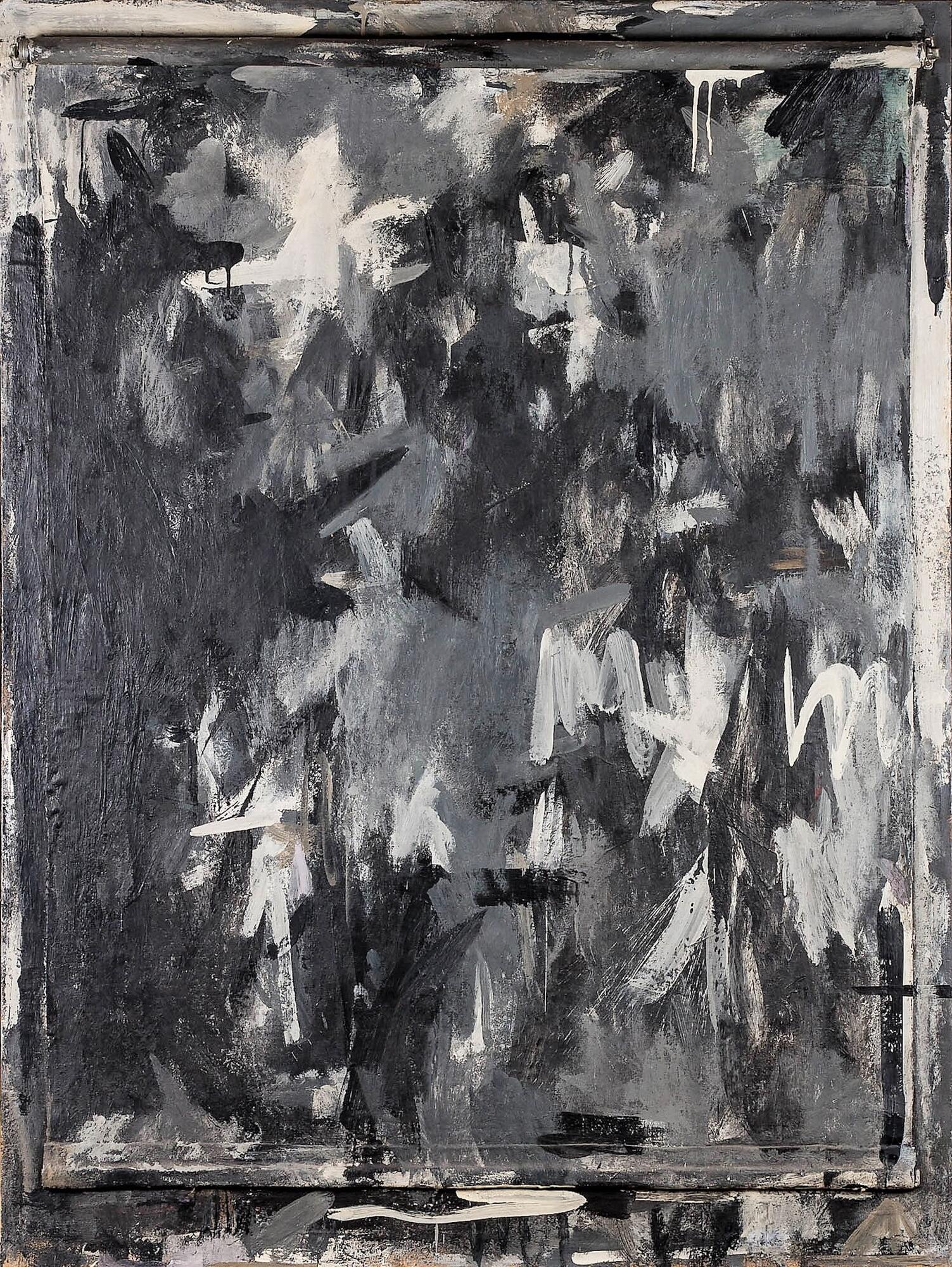
Jasper Johns's Shade (1959). Oil on canvas and wood on canvas.
"You stare at and into a field whose darkness is Absolute," writes Steinberg, "whose whites brighten nothing, but make darkness visible, as Milton said of eternal shade" (309).10 Even as we pursue the textual trails blazed by titles (however minimalist) as well as by verbalizable signs, we must reckon with the subsemiotic elements of art and with all the ways in which they resist translation into words. This resistance is obvious in paintings we normally classify as abstract. But we may have just as much trouble seeing how illusory figures--figures that prompt us to recognize and name them at once--can resist our naming. Take for instance what René Magritte does with the image of the window, a traditional metaphor for painting that literally as well as figuratively frames the rules of perspective formulated in the Renaissance. By translating the three dimensions of visual experience into two, Renaissance masters such as Alberti led viewers to embrace the illusion that they were looking through an open window: seeing rather than reading.11
We feel anew our bondage to this illusion every time it is broken. In Magritte's deliciously titled Le soir qui tombe ("Evening Falls"), the sharp, pointed fragments of a window pane that has been painted to represent a rural sunset are shown fallen to the floor.
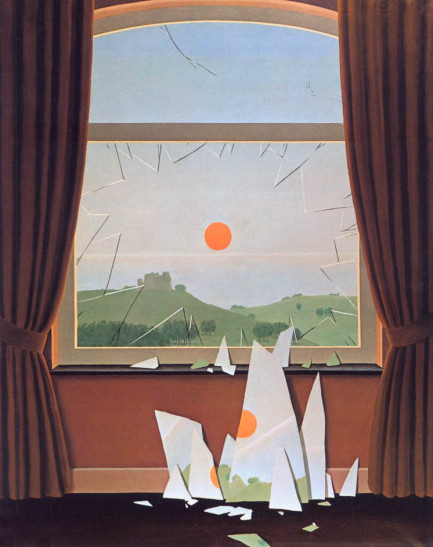
René Magritte, Evening Falls II / Le Soir qui Tombe (1964).
Oil on canvas. Houston, Menil Collection.
Paradoxically, paintings such as this confirm the power of illusion in the very act of playfully undermining it. We cannot even discuss such paintings without referring to some of their elements as if they were real objects, as I did just now in mentioning "fragments of a window pane."
Magritte also staged a now famous contest between verbal and pictorial signs by juxtaposing them in a single painting, La trahison des images (The Treachery of Images), best-known by the legend written across the bottom: "Ceci n'est pas une pipe" ("This is not a pipe").
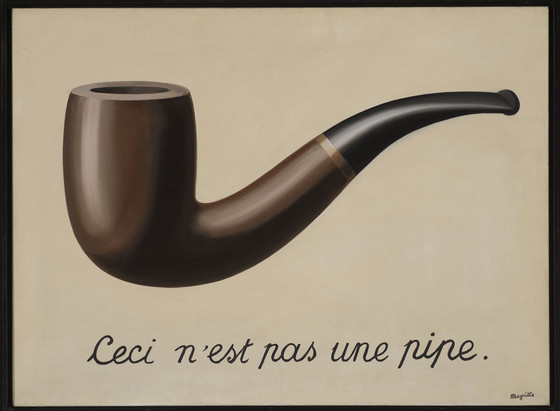
Rene Magritte, La Trahison des Images (1929). Los Angeles
County Museum. Los Angeles, CA
No one who reads French can fail to read the legend--in the strict lexical sense--while looking at what is pictured above it, which we instinctively read as a pipe. In the face of the legend's denial, Rudolph Arnheim probably spoke for all first-time viewers and readers when he declared, "Unfortunately, a pipe is all it is" (141). To make sense of the written legend, however, we must move beyond instinctive recognition to understand that a picture of a pipe is not the same as a pipe but is "just a representation," as Magritte himself once remarked (qtd. in Torczyner 71). Alternatively, we could read the pictured object and the legend together as saying that a pictorial sign is not the same as a verbal sign. While neither is identical with what it signifies, the conceptual object signified by "pipe" is far more polysemous than the visible object signified by the picture.
While "pipe" may denote both a wide range of smokeable instruments and a wide range of tubes, the pictured object circumscribes its own signifying power and thus forecloses its identification with anything three-dimensional. Since actual pipes do not usually appear in perfect profile or hanging suspended with no visible means of support, we must conclude that this is not, after all, a picture of a pipe but rather, as Michel Butor observes, a picture of depiction, a picture of the way pipes are commonly represented "dans la publicité ou surtout dans les manuels ou aiche scholairs" ("in advertising or above all in textbooks and school posters"; 77): isolated, radically decontextualized, and labeled "pipe."
Magritte's legend parodies this labeling of pictures and undermines the assumptions on which it is based. Instead of implying--as labels typically do--that the picture is identical to a particular object, the label denies that identification and turns the picture into an arbitrary sign, a picture of a certain class, as Nelson Goodman would say.12 Like a round picture or a square picture, a pipe picture can signify anything at all. Its meaning is no more bound to a particular object than is the meaning of the word ceci ("this") below it, which can mean this object pictured above it, this whole painting in which it appears, or this very word itself, ceci, which presents itself not only verbally but also visually. Ceci is at once a sliding signifier and a graphic sign, the carefully drawn picture of a written word. In fact the calligraphic shape of the c's in this word makes them visually rhyme with the pictured shape just above them. Magritte thus deconstructs the opposition between the natural meaning of depicted objects and the arbitrary signification of words even as he cuts the cable binding pictured objects to real ones.
At the same time, as Michel Foucault perceives, Magritte forges a new cable between words and pictures precisely by depicting words--representing them as pictured objects--and challenging us to read them as such. "Because the words we now can read underneath the drawing," Foucault writes, "are themselves drawn . . . , I must read them superimposed upon themselves. They are words drawing words; at the surface of the image, they form the reflection of a sentence saying that this is not a pipe. The image of a text" (23; my emphasis).
Clearly meaning by "image" (a French-English cognate) what I have called "picture," Foucault identifies the point at which the line between picture and text seems to disappear. Yet, just as we cannot fail to see the difference between a printed sentence and a calligraphically handwritten one, we can still less overlook the difference between reading "Ceci n'est pas une pipe" by itself and reading it as a legend beneath a particular kind of pictured object. Traditionally, words depicted in a painting but not represented as appearing in a book or any other text have signified speech, as in paintings of the Annunciation, where a thin ribbon of scroll sometimes tells us what the angel is saying to Mary (who is--not incidentally--typically represented as reading).13
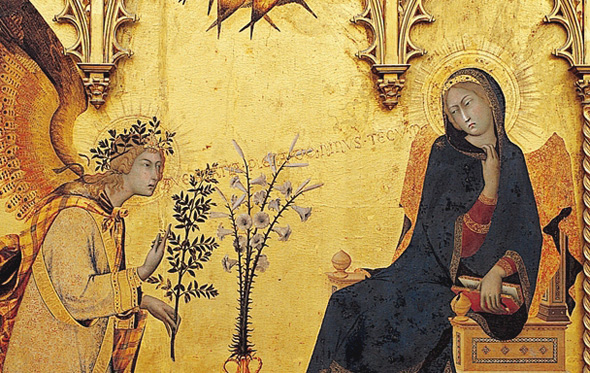
Simone Martini and Lippo Memmi, Annunciation (ca. 1333).
Detail of tempera and gold on panel. Florence, Uffizi Gallery Museum.
On a strip running from the angel's mouth to Mary's face, the words
AVE GRATIA PLENA DOMINUS TECUM are barely legible
Somewhat ironically, the contemporary counterpart of this convention is the speech bubble, regularly used in comic books and conspicuously featured in the work of Roy Lichtenstein, who repeatedly recreated comic book panels in paintings such as Masterpiece.14
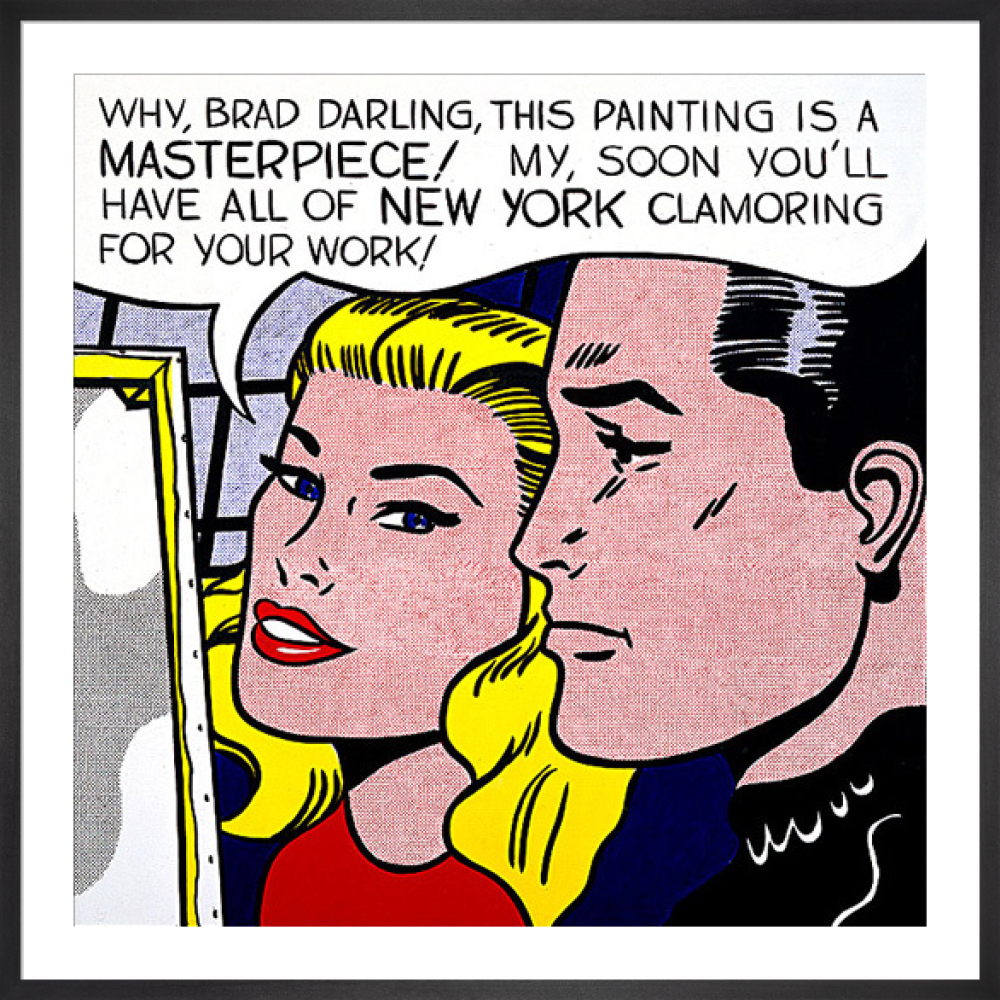
But Magritte's "Ceci n'est pas une pipe" is not spoken by anyone in the painting. It is offered in place of a label for what is depicted above it. And in taking the place of a label, or rather in displacing a label, Magritte's legend radically destabilizes the meaning of the pictured object and at the same time prompts us to read the legend itself as a picture, not just as a text. Since Magritte has depicted ceci to resemble the bowl of a pipe, it may be that any word or words can be pictured: designed to be read as pictorial.
To test this hypothesis, consider briefly how three contemporary artists have depicted words alone: not as legends, labels, or complements to pictured objects, but as pictured objects in their own right.15 Instead of turning words into calligraphic curves, as Magritte does, these artists preserve some form of standard typography--the sort of lettering we routinely find in printed texts or on public signs.
Jenny Holzer, for one, has been using words to make visual art since 1977, when she started pasting her one-line "truisms" (printed in black italics on white broadsheets) onto public buildings in and around Manhattan. In 1982, she began using LEDs (light-emitting diodes) to display statements such as "Protect Me from What I Want" and "Private Property Created Crime" on the Spectacolor board in Times Square. In 1989, for an exhibition called Laments, she carved aphorisms such as "I see space and it looks like nothing and I want it around me" into the tops of thirteen stone sarcophagi laid in a row, each cut into one of three sizes (infant, child, and adult). These lapidary inscriptions were repeated in flashing words that flowed from floor to ceiling in columns of ascending light. Juxtaposing the permanence of stone with the kinetic energy of LED light as two radically contrasting media of communication, Holzer created what Roberta Smith calls "an elaborately perceptual environment whose nonverbal effects are as powerful as its linguistic ones."16 More recently, Holzer has quite literally highlighted the nonverbal impact of her art by electronically representing only the words of others, particularly the poetry of Wislawa Szymborska, which--in her work called Projections (2009)--she conveyed by a Cameleon Telescan projector into the exhibition space.17
While Holzer's work quite obviously bursts the frame of traditional art and literally radiates into public spaces, rectangular frames enclose all the words represented by one of her somewhat younger contemporaries, who has been called "probably the most important American painter of his generation" (Schjeldahl). Christopher Wool makes black-and-white pictures by stenciling words in enamel, usually on aluminum panels, as below:
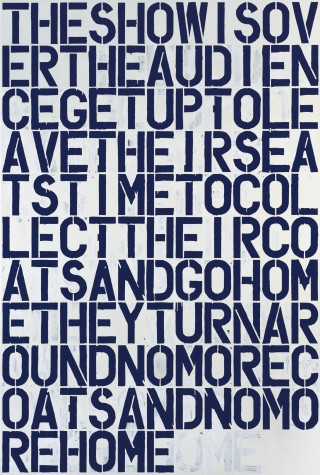
Wool's Untitled, 1990--91 is a work of art that radically disorients the viewer even as it demands to be read. Whereas thick black stenciled letters are typically used to issue simple statements or unmistakably clear orders on public signs (No Smoking, No Parking), these stenciled letters look at first like alphabet soup. As infants, we learn to distinguish one word from another in the stream of spoken language, for without first developing this ability we would never learn to understand any language, much less learn to read. Deconstructing this essential foundation of the spoken and written word, Wool's painting not only jams words together but cuts them off with no regard for syllables, let alone syllable-based hyphenation. As a result, it takes considerable time and effort to figure out where each word of this painting begins and ends:
THE SHOW IS OV
ER THE AUDIEN
CE GET UP TO LE
AVE THEIR SEA
TS TIME TO COL
LECT THEIR CO
ATS AND GO HOM
E THEY TURN AR
OUND NO MORE C
OATS AND NO MO
RE HOME
To make Wool's stenciled words a little easier to read in the lexical sense, I have spaced them properly while preserving his syllable-breaking line endings. Whatever we make of these stenciled words, it is obvious that we cannot make anything out of the painting without at least trying to read them in the lexical sense. Extracted from their stenciled density, they might be read as a prose poem about sabotaging conventional expectations: turning from a play, which typically dramatizes some disruption of the status quo, the audience mechanically returns to the familiar world of coats and home--only to ind both of them gone, "no more" to be found. The painting intensifies this defamiliarizing effect by turning from the familiar world of printed words to the preliterate, preconscious stage at which we first learned to distinguish one word from another--and forcing us to learn this all over again. Thus, the impact of the painting depends just as much on the artist's way of depicting its words as on the words themselves.
This is equally evident in the video installations of Tsang Kin-Wah, a Chinese artist born in 1976 whose work features ribbons of unspaced words that are either painted on aluminum or projected onto walls and floors. Since 2009, he has produced several installations of a video series titled The Seven Seals--the latest of which, Nothing, was mounted in Hong Kong in the fall of 2016. While his projection of texts that move obviously recalls the work of Holzer, Tsang's ribbons of text evoke at once the modernity of filmstrips and the antiquity of scrolls--such as those used to signify speech in paintings of the Annunciation, as noted above. But Tsang's floating texts are also meant to recall the scroll in Revelation, the scroll whose seven seals could be opened only by the Lamb, a symbol of Christ (Complete Bible, Rev. 5.1--10). Likewise, Tsang's Ecce Homo Trilogy I (2012) prompts us to view the 1989 trial and execution of Nicolae Ceausescu, the onetime dictator of Communist Romania, through the lens of what Pilate said when presenting the scourged, thorn-crowned Christ to a crowd bent on crucifying him: "Ecce homo," in the Latin of the Vulgate ("behold the man" [Complete Bible, John 19.5]).
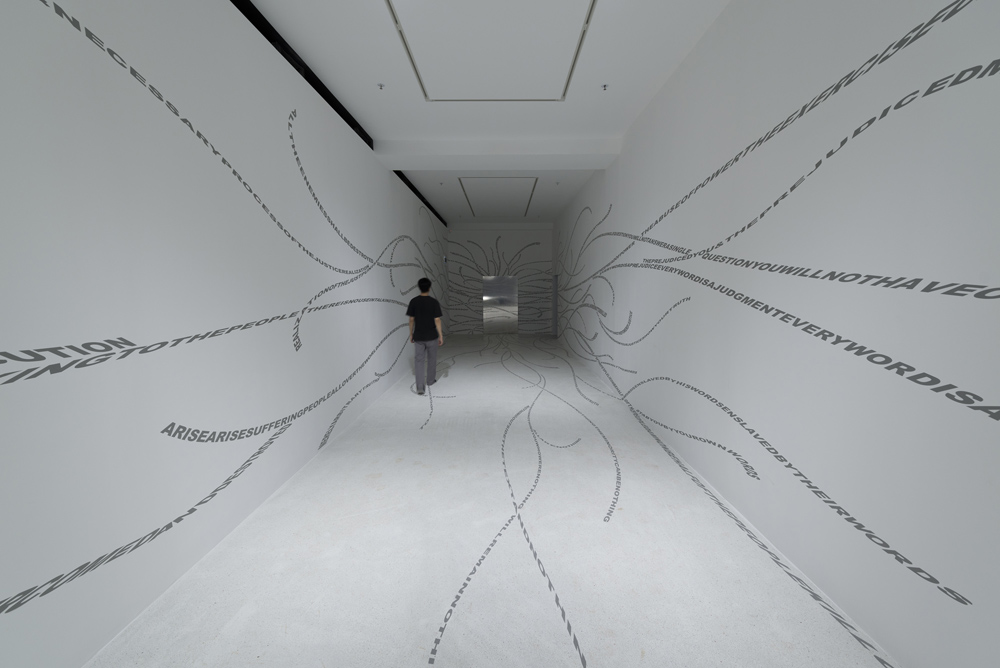
Tsang Kin-Wah, Ecce Homo Trilogy I. Photo of site-specific video, text, and painting
installation at Pearl Lam Galleries, Hong Kong (2012).
Bizarre as it may seem to associate Ceausescu with Christ, Tsang aims to show--or remind us--that the Romanian dictator and his wife were both presumed guilty and displayed on television for all to behold before being summarily shot by a firing squad. En route to projection rooms showing edited footage of Ceausescu's show trial, execution, and burial, visitors to Tsang's exhibition space walk through a corridor on whose walls and floor float ribbon scrolls of projected text such as "EVERYWORDISAJUDGMENT," "ENSLAVEDBYTHEIRWORDS," "DAMNINORDERNOTTOBEJUDGED," and "TYRANNIZETHETEXT." Laid out this way, in straight lines, Tsang's pithy apothegms are slightly easier to read than Wool's paintings, which run statements as well as words together. But Tsang's words do not come to us in consecutive straight lines. They appear as writhing, sometimes intersecting scrolls that defy us to read them in order, instead enveloping us as witnesses to what Tsang calls "the powerlessness of the accused, the absurdity of the judgment, the brutality of the execution and the sorrow of life and death" (qtd. in Chan A3).
Reading pictures, then, means first of all digesting the words that inhabit or surround them: words in pictures, words framing pictures by way of titles or wall captions, and words of the texts to which pictures allude or of the stories they suggest. But while pictures almost always come to us embedded in language, they are not the same as texts. Even though many of their elements may be construed as signs, a pictorial sign is not the same as a verbal sign, or even anything like a noun or a verb, as Marin proposed. Magritte's famous picture of a nonpipe dramatizes the difference between reading a word and reading a picture, whatever its color or shape: if the two were the same, Magritte's picture would be simply absurd rather than endlessly provocative. To read pictures, we must reckon with this difference even while reading the words that surround, inform, and sometimes invade them. We must also reckon with subsemiotic elements: spots of color that hover on the edge of signification, or markings such as the laddered brushstrokes with which Van Gogh portrays or rather overlays the words of Isaiah. We must be willing to read whatever remains illegible in a textual sense, whatever in a painting resists being verbalized or turned into a sign. In so doing, we challenge and stretch our conception of what it means to read anything at all.
On Bloom's secondary impotence, see Henke 254.↩︎
See Martini and Memmi's Annunciation (c. 1333)--

Simone Martini and Lippo Memmi, Annunciation (ca. 1333). Detail of tempera and gold on panel.
Florence, Uffizi Gallery Museum.
and Raphael's Annunciation (1502).
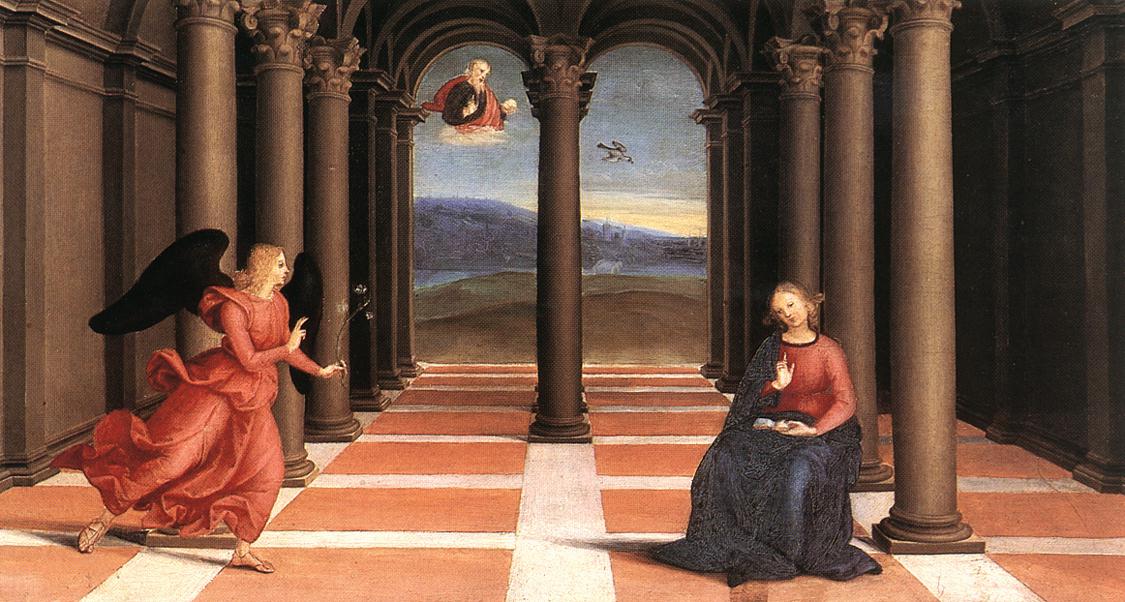
Raphael, Annunciation (1502-03). Oil on canvas. Rome, Pinacoteca Vaticana.↩︎
I have elsewhere offered an interpretation of Sally Mann's photograph Sunday Funnies as well as of several abstract paintings by Gerhard Richter (Heffernan 36--38, 300--09).↩︎
All translations are mine unless otherwise noted.↩︎
While reaffirming that language works with arbitrary signs, Lessing goes on to say that poetry "must try to raise its arbitrary signs to natural signs: only that way does it differentiate itself from prose and become poetry" (qtd. in Krieger 49). Just as painting aims to create the illusion that we are seeing at least one object that actually exists in space, poetry should create the illusion that we are witnessing events that actually follow others in time. Despite his critique of literary pictorialism, Lessing believed that poetry should take as its model the illusionism of visual art.↩︎
While fully allowing for the role of convention in the history of styles, Gombrich argued that art progresses "from the schematic to the impressionist" (Art and Illusion 293), modifying the "real shape" of objects "in order to match the here and now of their appearance at a given moment" (295). If, he shortly adds, we can assume that Constable's painting of Wivenhoe Park represents the park, "we will also be confident that this interpretation"--the painting itself--"will tell us a good many facts about that country-seat in 1816 which we would have gathered if we had stood by Constable's side" (299).↩︎
Though Gregory the Great declared around 600 CE that pictures were the "books" of the illiterate (Yeazell 114), the pictures in the so-called bibles of the poor were studded with inscriptions typologically linking the Old Testament to the New Testament (Block C):
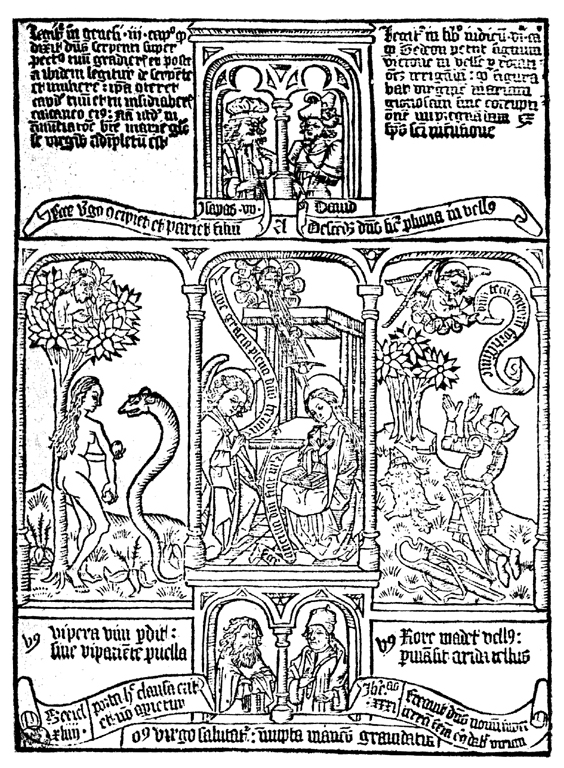
th 5. 50-Part Blockbook Xylo-5, Plate 3 (Block C).
Netherlands 1480-95. Paris, Biblioteque Nationale de France.
Warburg Institute Iconographic Database.
They could hardly be understood by anyone illiterate who did not hear them verbally explained.↩︎
For my discussion of Constable here and of Magritte below, Baylor UP has kindly allowed me to adapt some material from my book Cultivating Picturacy (29--31, 23--24).↩︎
For a comprehensive study of lectoral art, see Stewart.↩︎
Steinberg refers to Paradise Lost (Milton, bk. 1, line 63).↩︎
"First of all about what I draw, I inscribe a quadrangle of right angles, as large as I wish, which is to be considered an open window through which I see what I want to paint" (Alberti 56). Shrewdly applying this metaphor to Johns's painting, Steinberg writes that while Alberti "compared the perspective diaphanes of the Renaissance to open windows," Johns "compares the adiaphane of his canvas to a window whose shade is down" (309).↩︎
[I]n saying that a picture represents a soandso," Goodman writes, "we mean not that it denotes a soandso but that it is a soandso-picture," a picture of a certain class or type (29). "To say that the adult Churchill is represented as an infant . . . is to say that the picture in question is an infant-picture" (29--30), whomever it represents.↩︎
Besides the Martini / Memi Annunciation shown above, see also Melchior Broederlam's early Netherlandish Annunciation, where in the lower left corner a curling scroll represents the kneeling angel as saying, "Ave Gratia Plena Dominus Tecum" ("Hail, full of grace, the Lord is with you"):
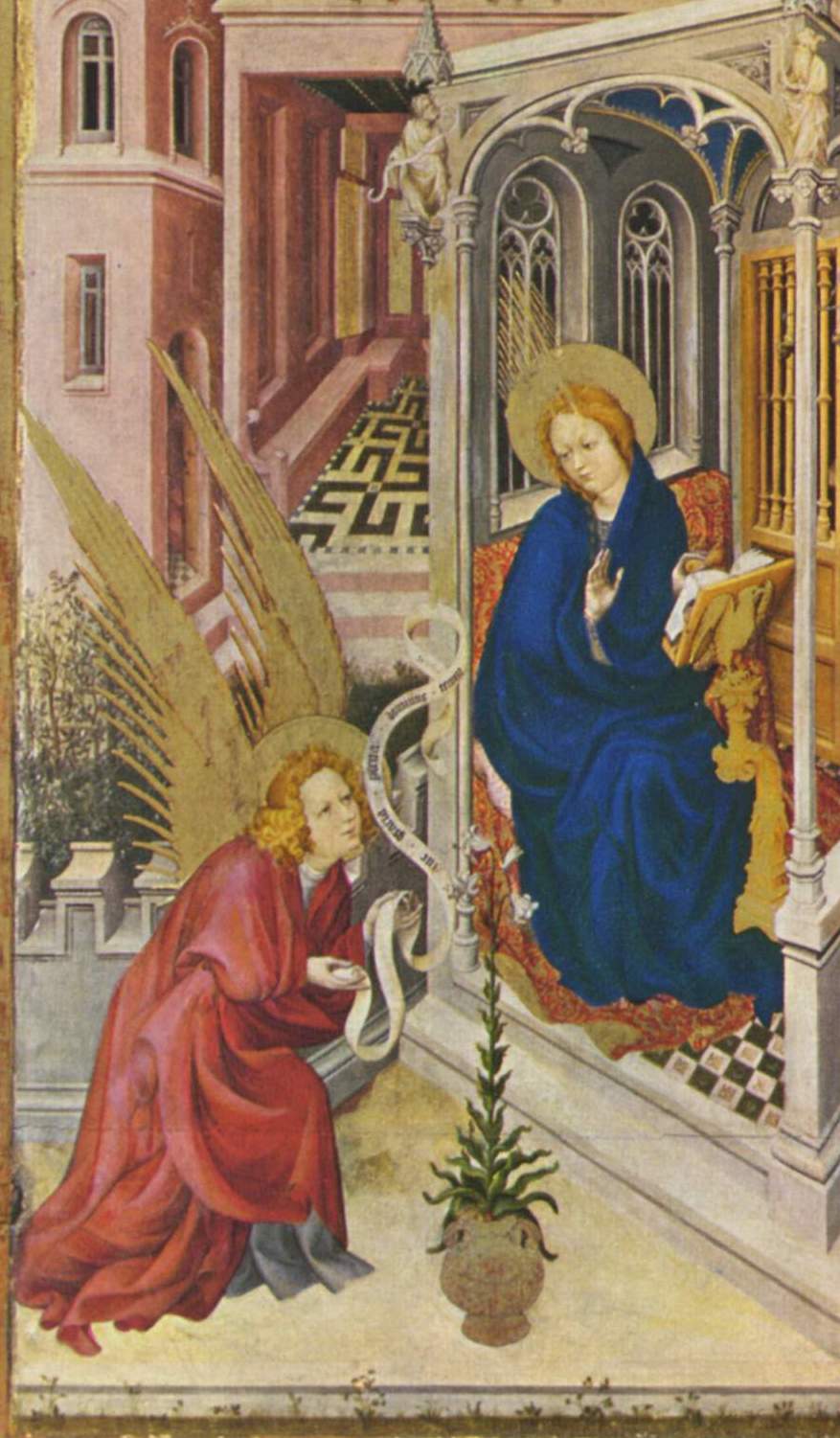
Detail of Melchior Broederlam, Annunciation and Visitation
(1393--1399).
Oil on panel. Dijon, Musée des Beaux-Arts.
↩︎
Probably alluding to Diego Velázquez's Las Meninas ("The Ladies-in-Waiting"), which shows the painter himself working on a canvas whose back alone we see along the let edge of the painting, Lichtenstein's Masterpiece shows a woman talking to a man about a painting that is likewise shown from the back in the very same position. Through a speech bubble she says, "Why, Brad darling, this painting is a masterpiece!" In re-creating the language, imagery, and speech bubbles of comic books, Lichtenstein wittily sends up the cultural veneration of would-be masterpieces (this one of course being invisible to the viewer) as well as the notion that high art--the art of silent masterpieces--has nothing to do with comic-book illustration, specifically the portrayal of faces who are shown speaking readable words.↩︎
Here as elsewhere in this article, my examples are based on Western languages and alphabets. A reader for PMLA has drawn my attention to Xu Bing, a contemporary Chinese artist whose installation Book from the Sky (first exhibited in Beijing in 1988) featured books and scrolls adorned with figures that look like Chinese characters but are linguistically unreadable.↩︎
It is worth noting the extent to which digital technology has overthrown the traditional assumption that works of art must be "still" in all senses of the word, motionless as well as silent--like Keats's urn. For instance, Ori Gersht's Pomegranate (2006) reveals that what seems to be a still life of a pomegranate, a cabbage, and a pumpkin is actually a high-definition film in which the pomegranate is struck by a bullet and then explodes in slow motion.↩︎
For a brief video showing how she displayed Szymborska's poetry in "Projection for Chicago" (2008), see Holzer.↩︎
Alberti, Leon Battista. On Painting, trans. John R. Spencer,
rev. ed. New Haven: Yale UP, 1966.
Arnheim, Rudolph. Visual Thinking. U of California P, 1969.
Barkan, Leonard. Mute Poetry, Speaking Pictures. Princeton:
Princeton UP, 2013.
Barrell, John. The Dark Side of the Landscape: The Rural Poor in
English Painting, 1730-1840. Cambridge: Cambridge University
Press, 1980.
Barthes, Roland. Camera Lucida: Reflections on Photography. Trans.
Richard Howard. New York: Hill and Wang, 1980.
Block C. Biblia pauperum, 1480--85, Bibliothèque Nationale
de France, Paris, Xylo-5. The Warburg Institute Iconographic Database.
Broederlam, Melchior. Annunciation and Visitation.
1393--99, Musée des Beaux-Arts, Dijon.
Bryson, Norman. Vision and Painting: The Logic of the
Gaze. New Haven, CT: Yale University Press, 1983.
Butor, Michel. Les Mots dans la Peinture. Geneva: Albert Skira,
1969.
Chan, David Ho Yeung. Ecce Homo Trilogy I (2011-12): "New Solo
Site-Specific Project by Tsang Kin-Wah."
Pearl Lam Galleries Hong Kong Edition (27 July-27 August, 2012) A1-A7.
Claude. Landscape with Hagar and the Angel. 1646, National Gallery, London.
The Complete Bible: An American Translation.
Translated by J. M. Powis Smith et al., U of Chicago P, 1951.
Constable, John. Dedham Vale. 1802, Victoria and Albert Museum, London.
---. John Constable's Correspondence, ed. R.S. Beckett. 6
vols. London: His Majesty's Stationer's Office, 1962-68.
---. Vale of Dedham. 1828, National Gallery of Scotland, Edinburgh.
Culler, Jonathan. Structuralist Poetics: Structuralism,
Linguistics, and the Study of Literature. Ithaca: Cornell
UP, 1975.
Dowley, Francis H. "Thoughts on Poussin, Time, and Narrative: The
Israelites Gathering Manna in the Desert," Simolius: Netherlands
Quarterly for the History of Art 25:4 (1997): 329-48.
Edwards, Cliff. Van Gogh and God: A Creative and Spiritual Quest.
Chicago, IL: Loyola University Press, 1989.
Elkins, James. "Marks, Traces, Traits, Contours, Orli, and Splendores:
Nonsemiotic Elements in Pictures," Critical Inquiry 21 (1995):
822-60.
Fruda, Niko H., "Emotions are Functional Most of the Time," in Paul
Ekman and Richard J. Davidson, eds. The Nature of Emotion:
Fundamental Questions (New York: Oxford UP, 1994): 112-26.
Foucault, Michel. This is Not a Pipe, trans. and ed. James Harkness.
Berkeley: U of California P, 1982.
"Ori Gersht's Pomegranate." YouTube, uploaded by Museum of Fine Arts
Boston, 20 Aug. 2012.
Gombrich, E. H. Art and Illusion: A Study in the Psychology of
Pictorial Representation. Princeton: Princeton UP, 1969.
---. "Image and Code: Scope and Limits of
Conventionalism in Pictorial Representation," in Image and Code,
ed. Wendy Steiner. Michigan Studies in the Humanities, No. 2.
(Ann Arbor: University of Michigan Press, 1981): 10-25.
Goodman, Nelson. Languages of Art: an Approach to a Theory of
Symbols. 2nd edition. Indianopolis: Hackett, 1976.
Heffernan, James A. W. Cultivating Picturacy. Waco, TX:
Baylor University Press, 2006.
Henke, Suzette A. James Joyce and the Politics of Desire.
New York and London: Routledge, 1990.
Holzer, Jenny. "Projection for Chicago." Art 21, 8 Mar. 2009.
Joyce, James. Ulysses: The Corrected Text, ed. Hans Gabler with
Wolfhard Steppe and Claus Melchior. New York: Random
House, 1986.
Krauss, Rosalind E. The Originality of the Avant-Garde and Other
Modernist Myths. Cambridge, MA: MIT Press, 1985.
Krieger, Murray. Ekphrasis: The Illusion of the Natural Sign.
Baltimore: Johns Hopkins UP, 1992.
Le Brun, Charles. Admiration with Astonishment. Circa 1800, Wellcome Images.
---. "Les Israelites Recueillant La Manne dans Le
Désert Par Nicolas Poussin." [Lecture given 5 November 1667
and recorded by André Félibien.] Conferences de l'Académie
Royale de Peinture et de Sculpture, ed. Henry Jouin (Paris:
A Quantin, 1883): 48-63.
Leslie, C.R. Memoirs of the Life of John Constable.
London: Phaidon, 1951
Lessing, G.E. Laocoön: An Essay on the Limits of Painting
and Poetry. Trans. Edward Allen McCormick. Baltimore: Johns
Hopkins UP, 1984.
---. Laokoon; oder, Über die Grenzen der Malerei und Poesie.
Project Gutenberg, 2004.
Lichtenstein, Roy. Masterpiece. 1962, Agnes Gund Collection, New York.
Magritte, René. Le soir qui tombe. 1964, Menil Collection, Houston.
---. La trahison des images. 1929, Los Angeles County Museum of Art, Los Angeles.
Marin, Louis. "On Reading Pictures: Poussin's Letter on Manna"
Comparative Criticism: A Yearbook 4 (1982): 3-18.
---. "Toward a Theory of Reading in the Visual Arts: Poussin's
The Arcadian Shepherds."
On Audience and Interpretation. Ed. Susan R. Suleiman
and Inge Crosman (Princeton: Princeton UP, 1980): 293-324.
Martini, Simone, and Lippo Memmi. Annunciation.
Circa 1333, Uizi Gallery Museum, Florence.
Milton, John. Complete Poems and Major Prose, ed. Merritt Y. Hughes.
Indianapolis: Hackett, 2003.
Mitchell, W.J. T. Iconology: Image, Text, Ideology. Chicago:
University of Chicago Press, 1986.
---. Picture Theory. Chicago: University of Chicago Press, 1994.
---. Image Science. Chicago: University of Chicago Press, 2015.
Panofsky, Erwin. Studies in Iconology: Humanistic Themes in the
Art of the Renaissance. New York: Harper & Row, 1962.
Philostratus. Imagines (Eikones), trans. Arthur Fairbanks.
Loeb Classical Library. London: Heineman, 1931.
Pliny the Elder. Natural History: A Selection, trans. John Healy.
London: Penguin, 1991.
Plutarch. Moralia, trans. Frank Cole Babbitt. Loeb
Classical Library. 4 vols. Cambridge, MA: Harvard University
Press. P, 1954. 4: 346F.
Poussin, Nicholas. Israelites Gathering Manna in the Desert.
1637--39, Musée du Louvre, Paris.
---. Lettres et propos sur l'art. Ed. Anthony Blunt.
Paris: Hermann, 1964.
Raphael. Annunciation. 1502--03, Pinacoteca Vaticana, Vatican City.
"Read, V. 7a." Oxford English Dictionary, Oxford UP, 2018.
Schjeldahl, Peter. "Writing on the Wall: A Christopher Wool Retrospective,"
New Yorker, October 27, 2013
Smith, Roberta. "Review/ Art: Flashing Aphorisms by Jenny
Holzer at Dia." New York Times, March 10, 1989
Sontag, Susan. "Against Interpretation," 20th Century Literary
Criticism: A Reader, ed. David Lodge (London: Longman, 1972):
652-60.
---. On Photography. New York: Picador, 1973.
Steinberg, Leo. 1972. Other Criteria. London: Oxford UP.
Stewart, Garrett. The Look of Reading: Book, Painting, Text.
Chicago: University of Chicago Press, 2006.
Torczyner, Harry. Magritte: Ideas and Images. Translated
by Richard Miller, H. N. Abrams, 1977.
Tsang Kin-Wah. Ecce Homo Trilogy I. Tsang Kin-Wah,
2018, www.tsangkinwah.com/work-ecce-homo-trilogy.
Van Gogh, Vincent. The Letters, ed. Leo Jansen, Hans Luijten, and
Nienke Bakker. Online edition November 2014.
---. Letter to Theo van Gogh, Etten, Wed.,
23 Nov. 1881. Vincent van Gogh: The Letters, Nov. 2014,
vangoghletters.org/vg/letters/let189/letter.html.
---. Still Life with Bible. 1885, Van Gogh Museum, Amsterdam.
Velázquez, Diego. Las Meninas. 1656, Museo del Prado, Madrid.
Whistler, James Abbott McNeill. Arrangement in Grey and
Black No. 1: Portrait of the Painter's Mother. 1871, Musée d'Orsay, Paris.
Wool, Christopher. Untitled, 1990--91. 1991, Luhring Augustine, New York.
Yeazell, Ruth Bernard. Picture Titles: How and Why Western Paintings
Acquired their Names. Princeton: Princeton UP, 2015.
Ziff, Jerrold. "Turner's First Poetic Quotations: an Examination of
Intentions," Turner Studies 2: 1(1982): 2-11.